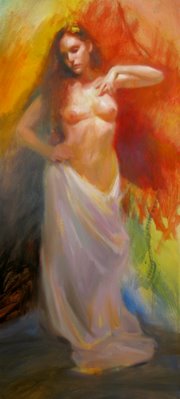
My favorite approach to figure painting is to leap into the process without hesitation. No preliminary drawings or daydreaming allowed! For this painting, the background was created beforehand by placing random marks and washes until a density of yellow hazy atmosphere is obtained. The canvas languished in my studio for nearly a year until the day I created this image. Somehow, the time was right, the surface was ready...like a wine that had come of age. I brought it to my model session with no doubt that it would be the chaos from which some kind of poetry would grow. The vertical thrust of the canvas suggested a standing pose, but the real inspiration was the dynamic pose of the model, who is a dancer.
Seeing how this painting appeared in it's earliest stage is exciting to me even now.

A few jagged lines suggest her movement without becoming too fixed or "perfect". I love working this way because it is accompanied by a real burst of energy, bravura and passion. As I squint to discern the visual pattern of light and shadow, I scrub in a luminous crimson wash to represent the darkness that seems to envelop her. The black wash on our left begins to define her light shape. At this stage, she resembles a spirit, an abstraction, but I do not stop here. My heart pounds. I always felt both liberated (and a bit guilty) when I began paintings this way. Shouldn't I be more concerned about clarity? Shouldn't my drawing skills be more controlled? Then I began finding X-rays of underpaintings by Titian and Velasquez where they began this way in the late Renaissance and Baroque periods. In an age of mathematical grids and royal patronage, they still let their brushes flow.

The next step is to focus. I begin with the face, which is built up with planes of structure which are gently softened together at their points of contact. Look how many edge variations I am employing. A few precious edges are left hard and sharp, but most dissolve and bleed into the areas surrounding them. I am careful to paint her features as they actually appear from across the room, not as detailed distractions. The overall quality of the skull, that is the bone structure, is most important here. The eye sockets appear deep and there is no defined eye, no actual glint of light. Just an indication of lid. The shadow under the nose falls across the lower face. The lips emerge from the forms of the muzzle, they are not pasted on the surface. The hairline comes and goes,allowing the strength of the nose and the light on the upper cheek to come forward. Less is more. Now I move down to the ribs and breasts.

Paying attention to the light source, each individual plane of the breasts is stated with a descriptive stroke of paint. The form appears to receed as cool green grey is added. See how the general shadow on the flesh is a warm sienna. Areas where bone comes close to the surface appear cooler. Also, the form appears to receed as cool green grey is added. The "lights" of her flesh are a very cool bit of blue added to white. I blend very slowly, trying to maintain the clarity of each decision. You can almost count the brushstrokes.

On to the arms. Every stroke is actually a drawing decision. This way of painting is not "filling in the space between the lines". There are no lines! It feels more like sculpting. See how the random colors of the background peek through or are subdued as I go along. I love the hair...

Total figure painting time thus far: Three hours.

Creating her fallen gown demands that a suggestion of the covered legs beneath be indicated. Alternating slashes of warm and cool violet are arranged as simply as possible, with only a single slash of light at the top. Again, notice the yellow wash of the background, allowed to show through to provide a unity, as well as a compliment to the violet. The rest of the cloth falls into soft middle values and finally into a muted shadow. I add a blast of cobalt blue near the bottom to enhance the temperature shift. The gown and the process of refining the fusion with the airy space around the form takes an additional hour of painting. The hands become a three hour delicate game of hide and seek, alternating between structure and mere indication. The hint of knuckle, the thrust of the gesture are more tasteful than tiny details. I decide to leave the vague background as it began: a chaotic wash, from which she boldly emerges. Here is the finished painting:

[
The Source by John Paul Thornton]








